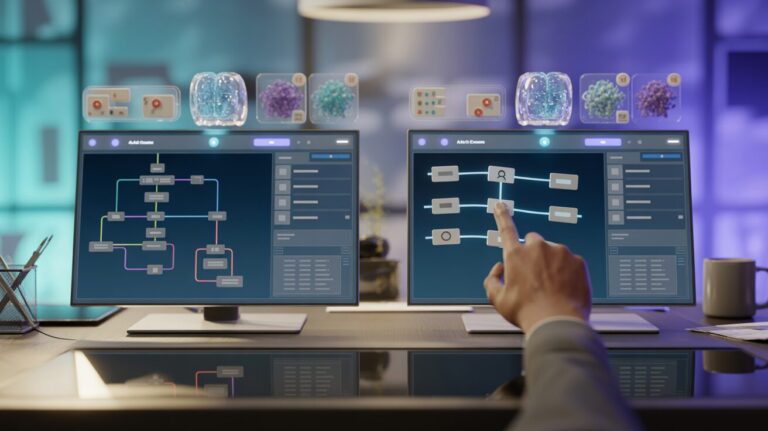Table of Contents
- Understanding Drag-and-Drop AI: The Basics
- The Evolution of AI Platforms: From Code to No-Code
- Key Components of Drag-and-Drop AI Platforms
- Benefits of Using Drag-and-Drop AI Platforms
- Real-World Use Cases Across Industries
- How to Choose the Right Platform for Your Needs
- Getting Started with Your First AI Application
- Future Trends in Drag-and-Drop AI
- Conclusion: Embracing the AI Revolution
Remember when creating websites required extensive coding knowledge? Today, tools like Wix and WordPress have made web development accessible to everyone through intuitive drag-and-drop interfaces. A similar revolution is now unfolding in artificial intelligence.
Artificial intelligence has long been perceived as the exclusive domain of data scientists and programmers with advanced technical skills. However, a new generation of platforms is changing this narrative by introducing drag-and-drop AI functionality – empowering anyone, regardless of their technical background, to harness the power of AI for their specific needs.
In this comprehensive guide, we’ll explore what drag-and-drop AI platforms are, how they work, and why they represent such a significant breakthrough in technology democratization. Whether you’re a small business owner, content creator, educator, or simply curious about AI, this article will help you understand how these intuitive platforms are making advanced technology accessible to everyone.
Drag-and-Drop AI Platforms
Democratizing AI Access for Everyone
What Is a Drag-and-Drop AI Platform?
A visual interface that allows anyone to build AI applications without writing a single line of code. Users can arrange pre-built components through simple mouse actions instead of complex programming.
Traditional AI Development
- Requires extensive coding knowledge
- Demands expertise in AI frameworks
- Takes months or years to develop
- High resource investment
Key Benefits
Democratized Access
Anyone can create AI applications regardless of technical background
Rapid Development
Create functional AI applications in days or hours instead of months
Fosters Innovation
Enables experimentation and diverse perspectives in AI development
Essential Components
Visual Interface
Interactive canvas for arranging and connecting AI building blocks
Pre-Built Components
Ready-to-use AI modules for various functionalities (NLP, vision, analysis)
Integration Tools
Connect with existing systems, import data, share results
Training & Testing Tools
Customize AI behavior with your data and validate performance
Real-World Applications
Small Business
Customer service chatbots, personalization engines
Education
Interactive tutoring, automated grading, language learning
Healthcare
Triage assistants, medical information chatbots
Content Creation
Analysis tools, transcription, interactive stories
Ready to Build Your First AI Application?
No coding required – create custom AI solutions in minutes with Estha’s intuitive drag-drop-link interface.
Understanding Drag-and-Drop AI: The Basics
At its core, a drag-and-drop AI platform is a visual interface that allows users to build artificial intelligence applications without writing code. Instead of programming, users interact with pre-built components or modules that they can arrange, connect, and customize through simple mouse actions – dragging elements onto a canvas and dropping them into place.
These platforms abstract away the complex algorithms and mathematical models that power AI, presenting them instead as user-friendly building blocks. Think of it as working with digital Lego pieces – each block performs a specific function, and by connecting different blocks together, you create a complete AI solution tailored to your needs.
The key innovation of these platforms lies in their visual programming approach. Rather than writing lines of code, users can:
- Select AI components from a library of options
- Drag these components onto a visual workspace
- Connect components together to create logical workflows
- Configure each component through simple forms and dropdowns
- Test their creation in real-time without compiling code
This visual approach transforms AI development from an abstract, code-heavy process into a tangible, intuitive experience accessible to anyone comfortable using basic computer applications.
The Evolution of AI Platforms: From Code to No-Code
The journey toward accessible AI has been gradual but transformative. Understanding this evolution helps appreciate the significance of today’s drag-and-drop platforms.
The Traditional AI Development Approach
Historically, AI development followed a resource-intensive path:
First came the era of custom coding, where organizations needed specialized data science teams proficient in languages like Python, R, or Java, along with expertise in AI frameworks such as TensorFlow or PyTorch. This approach required substantial investment in both talent and infrastructure, limiting AI adoption to large tech companies and academic institutions.
Next emerged AI APIs and services from cloud providers that simplified implementation somewhat but still required programming knowledge to integrate. While these represented progress, they maintained a significant technical barrier.
The Rise of Visual AI Development
The initial wave of simplified AI tools introduced visual interfaces for specific tasks like creating chatbots or basic machine learning models. These early platforms demonstrated that AI development could be made more accessible but often lacked the flexibility to create truly custom solutions.
Today’s comprehensive drag-and-drop AI platforms represent the culmination of this evolutionary process – offering both accessibility and powerful customization options. Platforms like Estha exemplify this approach, enabling users to create sophisticated AI applications through intuitive visual interfaces while maintaining the flexibility to build truly personalized solutions.
Key Components of Drag-and-Drop AI Platforms
Modern drag-and-drop AI platforms typically incorporate several essential elements that enable non-technical users to create functional AI applications:
Visual Interface
The heart of any drag-and-drop platform is its visual workspace or canvas. This interface allows users to visualize their AI application’s structure and workflow. The best platforms offer clean, intuitive designs that clearly show how different components connect and interact. The visual nature of these interfaces makes complex AI concepts more accessible by translating abstract ideas into concrete, manipulable objects.
Pre-Built AI Components
These platforms provide libraries of ready-to-use AI modules that encapsulate specific functionalities. Common components include:
Natural Language Processing (NLP) modules that enable applications to understand and generate human language – essential for creating chatbots, content analyzers, or language translators. Computer Vision components that allow applications to interpret and work with visual information. Text analysis tools that can extract insights, sentiment, or specific information from written content. Decision-making modules that can evaluate conditions and determine appropriate responses based on user-defined rules.
Connectors and Integration Tools
For AI applications to be truly useful, they need to connect with existing systems and data sources. Modern drag-and-drop platforms include integration capabilities that allow users to:
Import data from various sources including databases, spreadsheets, or online services. Connect to third-party applications and APIs. Export results to different formats or destinations. Embed finished AI applications into websites, mobile apps, or business systems.
Training and Customization Options
While pre-built components provide the foundation, effective AI solutions require customization to specific needs. Advanced drag-and-drop platforms offer user-friendly ways to:
Train AI models on custom datasets without writing code. Adjust parameters and settings to fine-tune AI behavior. Create personalized knowledge bases that inform AI responses. Define custom workflows and decision paths appropriate to specific use cases.
Testing and Deployment Tools
The final crucial element of comprehensive platforms is the ability to test and deploy created applications. This typically includes:
Real-time testing environments to validate AI functionality. Analytics and performance monitoring capabilities. Multiple deployment options (web, mobile, API, embedded). Version control and iteration capabilities to refine applications over time.
Benefits of Using Drag-and-Drop AI Platforms
The shift toward visual, no-code AI development offers numerous advantages that extend far beyond mere convenience:
Democratization of AI Technology
Perhaps the most significant benefit of drag-and-drop AI platforms is how they democratize access to advanced technology. By removing the coding requirement, these platforms enable professionals across all industries to leverage AI capabilities that were previously inaccessible without technical expertise or substantial resources.
This democratization means that specialized knowledge in domains like healthcare, education, finance, or creative arts can now be directly translated into AI applications by the very people who possess that expertise – without requiring an intermediary developer to interpret and implement their vision.
Accelerated Development Timeline
Traditional AI development cycles can stretch from months to years, depending on the complexity of the project. Drag-and-drop platforms dramatically compress this timeline, enabling the creation of functional AI applications in days or even hours.
This acceleration occurs because these platforms eliminate many time-consuming steps in traditional development: writing and debugging code, configuring development environments, and implementing basic AI functionalities from scratch. By starting with pre-built, tested components, users can focus immediately on the unique aspects of their application.
Reduced Resource Requirements
Conventional AI development demands significant investment in specialized talent, development infrastructure, and ongoing maintenance. Drag-and-drop platforms substantially reduce these costs by:
Eliminating the need for dedicated AI developers or data scientists for basic applications. Reducing infrastructure costs through cloud-based development environments. Decreasing maintenance complexity through standardized components and managed services. Lowering the learning curve for creating and modifying AI applications.
Increased Innovation and Experimentation
When the barriers to AI development are lowered, experimentation flourishes. Drag-and-drop platforms create an environment where users can quickly test ideas, gather feedback, and iterate on their designs without significant upfront investment.
This accessibility encourages innovation by enabling a broader range of perspectives and expertise to contribute to AI development. Solutions emerge from diverse fields and applications that might never have been explored under the traditional AI development paradigm.
Real-World Use Cases Across Industries
Drag-and-drop AI platforms are enabling innovations across numerous sectors. Here are some compelling examples of how these tools are being applied:
Small Business Applications
Small businesses are leveraging drag-and-drop AI to create capabilities previously available only to enterprises:
Customer service chatbots that handle common inquiries 24/7, freeing human staff for more complex interactions. Personalized recommendation engines that analyze customer preferences and suggest relevant products, enhancing the shopping experience without requiring sophisticated data science. Automated content generation tools that help maintain active blogs and social media presence despite limited marketing resources. Inventory management systems that predict demand patterns and optimize stock levels based on historical data and seasonal trends.
Education and Training
Educators are creating custom AI applications to enhance learning experiences:
Interactive tutoring systems that adapt to individual student needs and learning styles. Automated grading assistants that provide immediate feedback on assignments while maintaining consistency in evaluation. Language learning companions that offer conversation practice and pronunciation guidance. Educational content generators that create customized exercises based on specific learning objectives.
Healthcare and Wellness
Healthcare professionals are developing specialized tools to improve patient care:
Patient triage assistants that help prioritize care based on symptom assessment. Medical information chatbots that explain procedures and answer common questions in patient-friendly language. Wellness coaches that provide personalized exercise and nutrition guidance. Mental health support applications that offer coping strategies and resources for managing stress or anxiety.
Content Creation and Media
Creative professionals are using drag-and-drop AI to augment their capabilities:
Content analysis tools that evaluate readability, sentiment, and engagement potential. Automated video captioning and transcription services. Interactive storytelling experiences that adapt narratives based on reader preferences. Art and music generation systems that collaborate with human creators to explore new aesthetic possibilities.
How to Choose the Right Platform for Your Needs
With numerous drag-and-drop AI platforms available, selecting the right one for your specific requirements is crucial. Consider these factors when evaluating options:
Ease of Use vs. Flexibility
Platforms typically fall somewhere on a spectrum from highly accessible but limited to more complex but flexible. Assess your technical comfort level and the complexity of your intended application. Some platforms prioritize simplicity with highly structured templates and workflows, ideal for beginners creating standard applications. Others offer more advanced customization options that might require a steeper learning curve but enable more sophisticated solutions.
Specialized vs. General-Purpose
Consider whether you need a platform focused on specific AI functionality or a more versatile tool:
Specialized platforms excel at particular applications like chatbots, content generation, or image recognition, offering deeper capabilities in their niche. General-purpose platforms like Estha provide broader functionality across multiple AI domains, allowing for more diverse applications through a single interface.
Integration Capabilities
Evaluate how well the platform connects with your existing systems and data sources:
Look for native integrations with tools you already use. Check for API access that allows custom connections when needed. Consider how easily the finished AI application can be embedded in your website, app, or business software. Verify compatibility with your data formats and storage solutions.
Scalability and Performance
Anticipate your future needs and growth trajectories:
Will the platform handle increasing volumes of data and users? Are there limitations on transactions, requests, or processing capacity? What costs are associated with scaling your application? Is performance consistent under varying load conditions?
Support and Community
Access to assistance and learning resources significantly impacts success:
Evaluate the quality of documentation and tutorials. Check for active user communities where you can seek advice. Look for responsive customer support channels. Assess the availability of templates and pre-built examples relevant to your use case.
Getting Started with Your First AI Application
Ready to build your first drag-and-drop AI application? Follow these steps to ensure success:
Define Your Application’s Purpose
Begin with a clear understanding of what you want your AI application to accomplish:
Identify the specific problem or need you’re addressing. Define what success looks like – how will you measure the application’s effectiveness? Consider who will use the application and in what context. Start with a manageable scope that can be expanded later.
Prepare Your Knowledge Base
Many AI applications rely on domain-specific information to function effectively:
Gather relevant content, data, or examples that will inform your AI’s responses. Organize this information in a structured way that aligns with your application’s purpose. Consider the tone, style, and depth of knowledge appropriate for your intended users. Identify gaps in your knowledge base that might need to be filled before launch.
Start with Templates
Most drag-and-drop platforms offer templates or starter projects that can accelerate your development:
Select a template that closely matches your intended functionality. Customize the template to reflect your specific requirements. Use templates as learning tools to understand platform capabilities and best practices. Don’t be afraid to modify or combine elements from different templates.
Test Iteratively
Effective AI applications emerge through cycles of testing and refinement:
Test early and often throughout the development process. Simulate various user interactions to identify gaps or issues. Gather feedback from potential users when possible. Make incremental improvements rather than attempting perfect functionality on the first attempt.
Deployment and Monitoring
Once your application is functioning well in testing, prepare for deployment:
Choose the appropriate deployment method for your use case (website embedding, standalone app, API integration, etc.). Set up analytics to track usage patterns and performance. Create a plan for ongoing maintenance and improvement. Establish a feedback mechanism for users to report issues or suggest enhancements.
Future Trends in Drag-and-Drop AI
The landscape of drag-and-drop AI is rapidly evolving. Here are some emerging trends to watch:
Increased Sophistication
As the technology matures, we can expect drag-and-drop platforms to offer increasingly powerful capabilities:
More advanced AI models accessible through simple interfaces. Greater customization options without increasing complexity. Expanded multi-modal capabilities combining text, image, audio, and video processing. Deeper integration with emerging AI research and capabilities.
Ecosystem Development
The most successful platforms are evolving beyond simple development tools into comprehensive ecosystems:
Marketplaces for sharing and monetizing custom AI components and applications. Community-driven knowledge bases and learning resources. Specialized templates and solutions for specific industries or use cases. Integration networks that connect complementary services and data sources.
Ethical AI Integration
As AI becomes more accessible, responsible implementation becomes increasingly important:
Built-in safeguards against harmful or biased applications. Transparent explanation of AI decision-making processes. Privacy-preserving development options. Compliance frameworks for regulated industries and sensitive applications.
Convergence with Other Technologies
Drag-and-drop AI is increasingly combining with other emerging technologies:
Integration with IoT (Internet of Things) for intelligent physical systems. Augmented and virtual reality experiences powered by accessible AI. Blockchain-based verification and transparency mechanisms. Edge computing capabilities that reduce cloud dependency.
Conclusion: Embracing the AI Revolution
Drag-and-drop AI platforms represent a fundamental shift in how we interact with and create technology. By removing technical barriers, these platforms are unlocking AI’s potential across industries, professions, and applications that previously couldn’t access these powerful capabilities.
This democratization of AI technology isn’t just about convenience—it’s about enabling a diversity of perspectives and expertise to shape the future of artificial intelligence. When educators, healthcare providers, small business owners, and creative professionals can directly translate their domain knowledge into working AI applications, we see innovations that might never emerge from traditional technology development channels.
The growing accessibility of AI development also raises important questions about responsibility, ethics, and the changing nature of work. As these tools become more powerful and widespread, continued attention to responsible implementation and thoughtful application will be essential.
For beginners taking their first steps into the world of AI creation, platforms like Estha offer an ideal starting point—combining intuitive interfaces with powerful capabilities that grow alongside your expertise and ambition. The barrier to entry has never been lower, and the potential for innovation has never been higher.
The question is no longer whether you need technical expertise to create AI applications; it’s what you’ll build now that this technology is at your fingertips.
Drag-and-drop AI platforms have fundamentally transformed who can create and benefit from artificial intelligence. By abstracting away the technical complexities and presenting AI capabilities as intuitive visual components, these platforms have opened the door for professionals across all industries to build custom AI solutions that address their specific needs and challenges.
The impact of this democratization extends far beyond convenience or cost savings. When domain experts can directly translate their knowledge into functional AI without technical intermediaries, we see innovations emerge from unexpected places – from classrooms and clinics to small businesses and creative studios.
As you consider exploring drag-and-drop AI for your own projects, remember that the most successful applications combine the power of AI with human expertise, creativity, and ethical consideration. The technology provides powerful tools, but your unique knowledge and perspective provide the vision that makes these tools truly valuable.
The future of AI isn’t just about what large tech companies develop – it’s increasingly about what you and others across diverse fields create when given access to these powerful capabilities. The AI revolution is here, and drag-and-drop platforms ensure that everyone has the opportunity to participate.
Ready to Create Your First AI Application?
No coding or prompting knowledge required – build your custom AI solution in minutes with Estha’s intuitive drag-drop-link interface.



